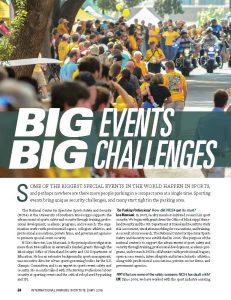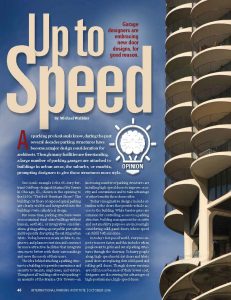by Vanessa R. Cummings, CAPP, M.Div.
Bringing the BEAST to customer service.
The beast is a process for you to put into practice every day, especially in difficult or unusual situations or when someone tries to take you over the limit. 
HAVE YOU EVER BEEN PUSHED TO YOUR PARKING LIMIT?
Have you had customers call you by a name other than your own? Have you felt the need to snap some parking sense into a customer? Customer service is one of the key complaints received about parking, and feedback ranges from courteous and professional to rude and inconsiderate. Excellent customer service is key to building positive relationships with our customers. Realizing that many negative comments stem from face-to-face interactions with parking professionals, it is important that those interactions be good ones.
This is true whether you work in the office or in the field. Customer interactions run the gamut from visitors needing directions, to drivers who need motorist assistance, to those who have received tickets. It is important not to jump to conclusions that everyone out there is “up against” you. If you are predisposed to that mindset, your interaction will start that way, primarily because you approached it on the defense. However, if your mind is focused on the fact that every interaction is an opportunity to serve, you will naturally be more kind, listen more, and respond with a positive tone.
When interactions are headed the wrong direction and not going well, you need a resource to call upon. Enter the parking beast! Yes, I said beast. Next time someone tries to take you to your frustration limit, you give them the customer service BEAST.
Who or what is this beast? The beast is a process for you to put into practice every day, especially in difficult or unusual situations or when someone tries to take you over your limit. The beast is nothing for you or your customers to fear; it brings a higher level of customer service to those customers on whom you may initially want to breathe fire. You will find that the beast should keep you from escalating the situation, help you de-escalate it, and show the customer that you know how to stay calm, even in stressful situations.
Breathe in.
Slowly take a deep, therapeutic breath in. This allows you to gather yourself, suck it up, and begin to clear your mind. Think about when people have pushed you to your limit—your breathing usually changes, and as a result, you may find yourself tensing up and breathing rapidly. A slow, deep breath will allow you to begin to control your breathing and may prevent your blood pressure from making a quick rise. It also occurs as a natural result because when you are about to lose your temper, you often take a quick deep breath so you can say everything you want (or sometimes just feel the need) to say. However, the slower you inhale, the more control you gain of yourself because you are focusing on your breathing and not what just occurred or was just said.
Breathing in is directly related to the next point that goes hand-in-hand with your survival and your health.
Exhale slowly.
Exhaling slowly only occurs when you take control and pay attention to how you are breathing. Slow exhalation allows you to cleanse the negative energy and thoughts and release the stressors you just inhaled. Slow breathing should reduce the rapid-fire,
knee-jerk response and allow you to begin calming yourself. As you are exhaling, begin to focus on a solution to the situation at hand and not the person or words spoken.
You may end up with the BEBEBEAST because you may have to do the first two steps two or three times. Repeat the first two steps as many times as you need to so you know you are in control of your breathing, and then move on to “A.” Introducing the BEAST
Adjust your attitude and perspective.
When someone has said or done something that does not sit well with you, your first response is often not the best response. Adjusting your attitude and perspective allows you to focus on problem resolution and not the person or his or her issue. There are people who will try to get a negative reaction from you to use against you to try to avoid responsibility for their actions. Remember, you are the parking professional so you are held to a higher standard. “Professional” means you maintain a level of maturity and respect even when disagreements and conflicts arise.
Adjusting your attitude and perspective requires you to consider: What if you were in the customer’s situation? How would you feel or react? Was the signage clear? What did he or she just say to you? Did the person try to do the right thing? Was he or she truly confused? What if that customer was your spouse or child? How would you want him or her to be addressed?
These questions should provide a reality check and open your mind to viewing the situation from a different perspective. That view should also result in an attitude adjustment (if you were headed the wrong way). The right attitude and perspective should
provide you with an appropriate response that will educate and uplift, not hurt. If you want to snap back, you should reassess and come up with a courteous response that could also help the customer to learn how to avoid the negative situation or adjust his or her attitude the next time.
Smile internally.
Before you speak, put a smile in your mind and a pleasant look on your face and remove any scowls or frowns. By smiling internally, what you say and how you say it should be much kinder than if you appear indifferent. Typically, a smile will alter the tone and tenor of what you say. Do not smile at the person as if you are happy to hand him or her a $100 ticket or look as if he or she should be happy to get a ticket. Remember to imagine yourself or your family member on the other end of the interaction.
A sincere facial effect conveys to the receiver that you are concerned about him or her and his or her situation, that you take him or her seriously; and it conveys respect. Respect goes a long way in customer service.
Talk to the Person.
Talk to the person, not at the person. Some people who have been mistreated by customers perceive situations as what they are up against. If your mindset is that you are up against people and situations, you will address those situations more defensively. Those who are up against something feel a need to rebel, respond, and take charge of
the situation.
As a parking professional, you should not approach the situation as being up against anyone. You provide a service to people who have chosen to use the service. If you want them to return and do things right the next time, you should talk to them in a manner that is welcoming, even when you may have to tell them “no” to cancelling their ticket or allowing them to park illegally. Again, place yourself on the receiving end of the interaction and how you would like to be addressed.
Breathe in.
Exhale slowly.
Adjust your attitude and perspective.
Smile internally.
Talk to the person, not at the person.
As you begin to think about bringing the BEAST, remember that customer service is just that: service. To serve implies doing something good to aid someone else. Writing tickets may not initially be understood as something good to the recipients, but those whose opportunities to find parking are improved appreciate the services provided.
Most people who have contact with parking professionals have questions and need information; they are not coming to complain or ask for favors. When that perspective is realized, the parking professional should bring a different and more positive approach to parking. If that is done, then your approach to those who are less than happy should reflect the parking beast and not a frustrated parking professional.
Imagine your staff wearing shirts that say, “Ask Me about the Parking BEAST!” It will provide a great opportunity to talk positively about parking and teach folks the rules before they park. Now, take the parking BEAST (or, if necessary the BEBEBEAST), with you, and enjoy your job and the people you serve!







